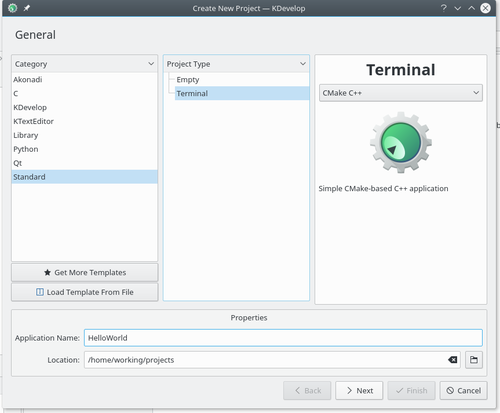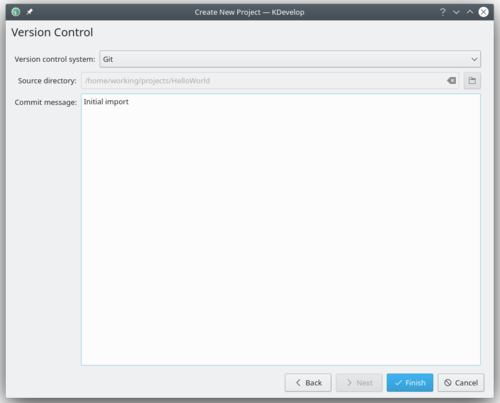KDevelop5/Manual/Sessions and projects/fr: Difference between revisions
ChristianW (talk | contribs) Created page with "* '''KDevelop''' vous demandera ensuite de choisir un gestionnaire de projet. Si ce projet utilise les fichiers make standards de Unix, choisissez le gestionnaire de projet du..." |
ChristianW (talk | contribs) Created page with "{{Prevnext2 | prevpage=Special:MyLanguage/Kdevelop5/Manual/Meet_KDevelop | nextpage=Special:MyLanguage/KDevelop5/Manual/Working_with_source_code | prevtext=Rencontre avec KDev..." |
||
| Line 75: | Line 75: | ||
{{Prevnext2 | {{Prevnext2 | ||
| prevpage=Special:MyLanguage/Kdevelop5/Manual/Meet_KDevelop | nextpage=Special:MyLanguage/KDevelop5/Manual/Working_with_source_code | | prevpage=Special:MyLanguage/Kdevelop5/Manual/Meet_KDevelop | nextpage=Special:MyLanguage/KDevelop5/Manual/Working_with_source_code | ||
| prevtext= | | prevtext=Rencontre avec KDevelop | nexttext=Travailler avec le code source | ||
| index=Special:MyLanguage/KDevelop5/Manual | indextext= | | index=Special:MyLanguage/KDevelop5/Manual | indextext=Retour au menu | ||
}} | }} | ||
[[Category:Development]] | [[Category:Development]] | ||
Revision as of 21:55, 23 June 2018
Sessions et projets: les bases de KDevelop
In this section, we will go over some of the terminology of how KDevelop sees the world and how it structures work. In particular, we introduce the concept of sessions and projects and explain how you can set up the projects you want to work on in KDevelop.
Terminologie
KDevelop has the concept of sessions and projects. A session contains all projects that have something to do with each other. For the examples that follow, assume you are the developer of both a library and an application that uses it. You can think of the core KDE libraries as the former and KDevelop as the latter. Another example: Let's say you are a Linux kernel hacker but you are also working on a device driver for Linux that hasn't been merged into the kernel tree yet.
So taking the latter as an example, you would have a session in KDevelop that has two projects: the Linux kernel and the device driver. You will want to group them into a single session (rather than having two sessions with a single project each) because it will be useful to be able to see the kernel functions and data structures in KDevelop whenever you write source code for the driver — for example so that you can get kernel function and variable names auto-expanded, or so that you can see kernel function documentation while hacking on the device driver.
Now imagine you also happen to be a KDE developer. Then you would have a second session that contains KDE as a project. You could in principle have just one session for all of this, but there is no real reason for this: in your KDE work, you don't need to access kernel or device driver functions; and you don't want KDE class names autoexpanded while working on the Linux kernel. Finally, building some of the KDE libraries is independent of re-compiling the Linux kernel (whereas whenever you compile the device driver it would also be good to re-compile the Linux kernel if some of the kernel header files have changed).
Finally, another use for sessions is if you work both on the current development version of a project, as well as on a branch: in that case, you don't want KDevelop to confuse classes that belong to mainline and the branch, so you'd have two sessions, with the same set of projects but from different directories (corresponding to different development branches).
Démarrer une session et importer un projet existant
Let's stick with the Linux kernel and device driver example — you may want to substitute your own set of libraries or projects for these two examples. To create a new session that contains these two projects go to the menu at the top left (or, if this is the first time you use KDevelop: simply use the default session you get on first use, which is empty). We next want to populate this session with projects that for the moment we assume already exist somewhere (the case of starting projects from scratch is discussed elsewhere in this manual). For this, there are essentially two methods, depending on whether the project already is somewhere on your hard drive or whether it needs to be downloaded from a server.
Option 1: Importer un projet d'un serveur de système de gestion des versions
Let's first assume that the project we want to set up -- the Linux kernel -- resides in some version control system on a server, but that you haven't checked it out to your local hard drive yet. In this case, go to the menu to create the Linux kernel as a project inside the current session and then follow these steps:
- Go to to import a project
- You then have multiple options to start a new project in the current session, depending on where the source files should come from: You can just point KDevelop at an existing directory (see option 2 below), or you can ask KDevelop to get the sources from a repository.
- Assuming you don't already have a version checked out:
- In the dialog box, under , choose to use , , or one of the other choices
- Choose a working directory as destination into which the sources should be checked out
- Choose an URL for the location of the repository where the source files can be obtained
- Hit . This can take quite a long while; depending on the speed of your connection and the size of the project. Unfortunately, in KDevelop 4.2.x the progress bar does not actually show anything, but you can track progress by periodically looking at the output of the command line command to see how much data has already been downloaded.
du -sk /path/to/KDevelop/project
- It asks you to select a KDevelop project file in this directory. Since you probably don't have one yet, simply hit
- Cliquez de nouveau sur
- KDevelop vous demandera ensuite de choisir un gestionnaire de projet. Si ce projet utilise les fichiers make standards de Unix, choisissez le gestionnaire de projet du makefile client
- KDevelop will then start to parse the entire project. Again, it will take quite a while to go through all files and index classes etc. At the bottom right of the main window, there is a progress bar that shows how long this process has come along. (If you have several processor cores, you can accelerate this process by going to the menu item, then selecting on the left, and increasing the number of threads for background parsing on the right.)
Option 2: Importer un projet qui est déja présent sur votre disque dur
Alternatively, if the project you want to work with already exists on your hard drive (for example, because you have downloaded it as a tar file from an FTP server, because you already checked out a version of the project from a version control system, or because it is your own project that exists only on your own hard drive), then use and in the dialog box choose the directory in which your project resides.
Configurer une application en tant que second projet
The next thing you want to do is set up other projects in the same session. In the example above, you would want to add the device driver as the second project, which you can do using exactly the same steps.
If you have multiple applications or libraries, simply repeat the steps to add more and more projects to your session.
Créer des projets à partir de rien
There is of course also the possibility that you want to start a new project from scratch. This can be done using the menu item, which presents you with a template selection dialog.

Some project templates are provided with KDevelop, some can be fetched from the internet by pressing the button , but even more are available by installing the KAppTemplate application. Choose the project type and programming language from the dialog, enter a name and location for you project, and click .

The second page of the dialog allows you to set up a version control system. Choose the system you wish the use, and fill in the system-specific configuration if needed. If you do not wish to use a version control system, or want to set it up manually later, choose . When you are happy with your choice, press .
Your project is now created, so you can try building or installing it. Some templates will include comments within the code, or even a separate README file, and it is recommended that you read those first. Then, you can start working on your project, by adding whatever features you want.

